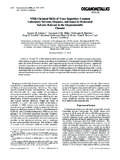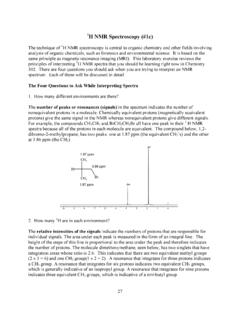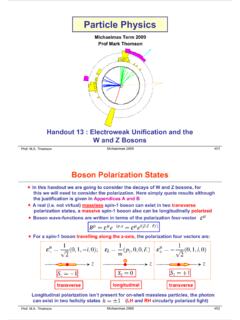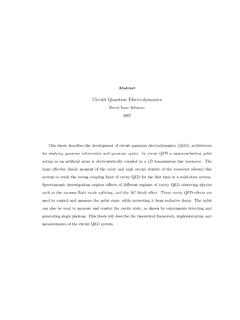Transcription of NMR of Proteins
1 NMR of ProteinsNMR of ProteinsDetermining protein Structures by NMRD etermining protein Structures by NMR the process of determining a solution structure by NMR is one of measuring many (hundreds/thousands) of short proton- proton distances and angles, and restraining the protein structure with these computationallyH H ..}d1H NMR Spectra of Proteins1H NMR Spectra of Proteins 1D, 1H NMR spectra of even small Proteins are impossible to interpret in any comprehensive manner -normally, only gross statements about secondary structure, tertiary structure, etc.
2 Can be madeubiquitin (76 amino acids, kDa)simple 1D 1H experiment9090t1 COSYt22D 1H COSY experimentcytochrome c, kDa for even moderate sized Proteins , addition of a second dimension still does not alleviate spectral crowding and overlap in 1H spectranD, heteronuclear NMR Spectra of ProteinsnD, heteronuclear NMR Spectra of Proteins Modern NMR spectroscopic studies of Proteins rely on multidimensional experiments involving 1H, 13C, and 15N nuclei in isotopically labeled Proteins These methods provide for signal selection (selectivity)
3 And a means to reduce signal overlap ubiquitin (76 amino acids, kDa)simple 2D 1H, 15N HSQC experiment In order to measure the distances between protons, we need to find out what protons give rise to the signals in the spectra, we have to assign the protein (figure out the chemical shifts for all of the protons) The methods used are based on heteronuclear spectra applicable to uniformly isotopically enriched Proteins -uniform 13C and 15N labeling: spin 1/2 -three nuclei (1H, 15N, and 13C) are involved based on magnetization transfer via (mostly) one bond J couplings -most of these couplings are large compared to linewidths for moderate sized Proteins (~20 kDa) -magnetization transfer is efficient -indirect (1H)
4 Detection provides selective chemical shift correlation -spectral degeneracy minimizedTriple Resonance ApproachTriple Resonance Approach Proteins can be uniformly isotopically labeled by recombinant expression using defined media -bacterial expression most common-also yeast, and cell-free systems are being developed -minimal media using 13C6 glucose as the sole carbon source and 15NH4Cl (or -SO4) as the sole nitrogen source-normally >98% atom excess-also labeled rich media ($$) -for larger Proteins , uniform or fractional 2H labeling also used-2H, 13C glucose and D2 OUniform Isotopic Labeling of ProteinsUniform Isotopic Labeling of Proteins - these 1J and 2J couplings are uniform throughout polypeptides/ Proteins - these 1J and 2J couplings are virtually conformation independent 1J and 2J Couplings in Proteins1J and 2J Couplings in Proteins correlates the chemical shifts of 1HN, 15N, 13C i and 13C i-1 Prototypical Triple Resonance Experiment.
5 HNCAP rototypical Triple Resonance Experiment: HNCA both 13C i and 13C i-1 chemical shifts are correlated -the peak for the intra-residue correlation is usually more intense (11 Hz 1 JNC coupling vs 7 Hz 2 JNC coupling )1H, 15N-HSQCHNCAP rototypical Triple Resonance Experiment: HNCAP rototypical Triple Resonance Experiment: HNCA2D HNCA projection3D HNCAT riple Resonance Approach: A Simple ExampleTriple Resonance Approach: A Simple ExampleTriple Resonance Approach: A Simple ExampleTriple Resonance Approach: A Simple Example link the correlated shifts or visuallyTriple Resonance Approach: A Simple ExampleTriple Resonance Approach: A Simple Example problems:13C chemical shift degeneracy in proteins13C linewidths/resolution -these preclude complete linkage via 13C alone -the same is true for 13C , 13C Triple Resonance Approach: HNCA/HN(CO)CA ExampleTriple Resonance Approach.
6 HNCA/HN(CO)CA Example The Nuclear Overhauser Effect or Nuclear Overhauser Enhancement is the change (enhancement) of the signal intensity from a given nucleus as a result of exciting or saturating the resonance frequency of another nucleus It is based on through-space interactions The magnitude of the effect is dependent on distance -enhancement depends on 1/r6, where r is the internuclear distance -thus, the effect is limited to distances of approximately 5 or less This provides a means to determine if any two protons in a protein are < 5 apart The basic experiment used for Proteins is called a NOESY909090 mt12D NOESYt2 The Nuclear Overhauser EffectThe Nuclear Overhauser Effectcytochrome c, kDa Even for relatively small Proteins , the 2D NOESY spectrum is hampered by severe spectral overlap-pulse sequences.
7 Combine 2D sequences to get 3D sequences-get increased dimensionality and increased resolution without an increase in the number of signals (peaks)909090 mt1 NOESYt2 HSQC 180 90 180 901H15 Ndecouple 9018018018090 t1/2t1/290t29090 mt1 NOESY-HSQC 180 90 180 9015 Ndecouple 9018018018090 t2/2t2/290t31H3D NOE Experiments for Distance Restraints3D NOE Experiments for Distance RestraintsLeft: 2D NOESYFar left: 2D plane of 3D NOESY- HMQC (1H, 13C)-1H signals resolved by 13C chemical shifts of bound 13C atoms3D NOE Experiments for Distance Restraints3D NOE Experiments for Distance RestraintsStructure CalculationsStructure Calculations the primary structural restraint information for high resolution protein structures are the NOE-based distance restraints -additional restraints include angle restraints based on coupling constants, long range restraints based on dipolar couplings.
8 Hydrogen bond restraints calculation of structures involves satisfying structural restraints using simulated annealing/ restrained molecular dynamics -a target/energy function including terms for covalent geometry (known bond lengths and bond angles) and experimental restraints is minimized -the molecule is computationally heated/cooled to attempt to find a global minimum the number of restraints is an important indicator of the quality of final structuresPractical Aspects of protein StructureDetermination using NMRP ractical Aspects of protein StructureDetermination using NMRI ntroductionIntroduction NMR vs X-ray crystallography for protein structure determination in an x-ray diffraction pattern, each datum (reflection)
9 Contains information about each atom in the asymmetric unit -each atom contributes information that contributes to the intensity of each reflection in an NMR spectrum, each datum (peak) contains information about only a single interatomic distance or angle -the process of determining a solution structure by NMR is one of measuring many small distances and angles one at a time Why use NMR? can t get a crystal / want to work in solution want to look at binding to other Proteins /molecules want to understand stability want to measure fast dynamics processes protein production protein purity Isotopic labeling NMR samples / conditions / tubes Simple spectra / evaluation (stability, tertiary structure)
10 protein size / magnet sizeIntroductionIntroduction Some things you should know before you talk to an NMR spectroscopist about determining a structureProtein productionProtein production protein sample(s) in theory, as little as a few mg of protein is sufficient-best if the protein sample for NMR is > 1 mM in practice, tens of milligrams (or more) are usually necessary, as are multiple samples -multiple samples if your protein is not stable -multiple samples with different isotopic labeling schemes many very good bacterial expression vectors/cell strains are available for expression in bacteria-good track record, easily automated expression in euka



